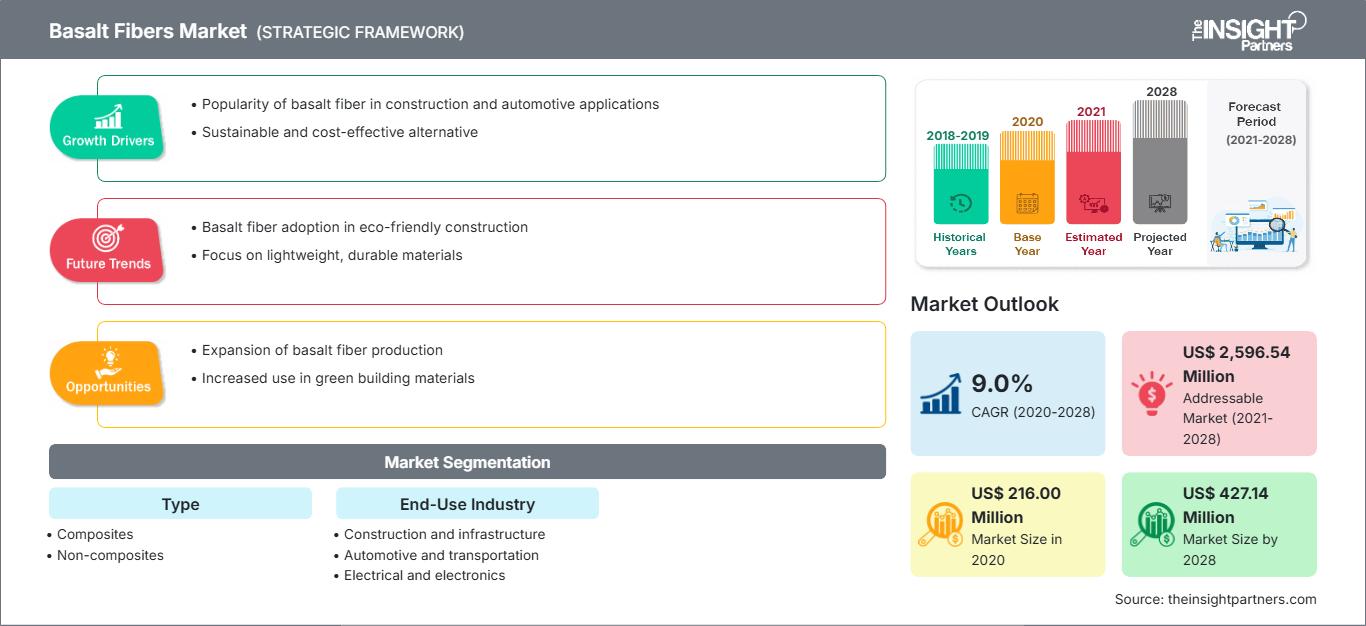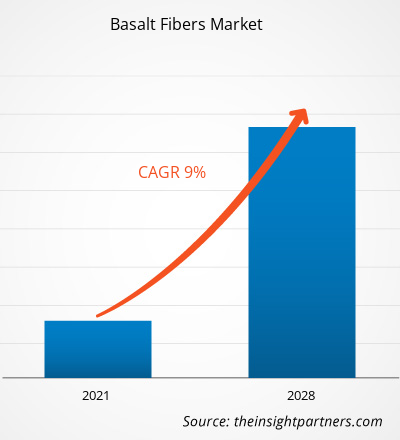El mercado de fibra de basalto se valoró en US$ 216,00 millones en 2020 y se proyecta que alcance los US$ 427,14 millones para 2028; se espera que registre una CAGR del 9,0% de 2021 a 2028.
La fibra de basalto posee propiedades químicas similares a las de la fibra de vidrio, pero presenta mejores propiedades fisicoquímicas que las de esta. Se prevé un alto crecimiento del mercado de la fibra de basalto debido a la demanda de industrias como la automotriz, la náutica, la construcción y la electrónica. El aumento de la actividad de construcción en varias regiones, debido al crecimiento de la población, el aumento de los ingresos y las iniciativas gubernamentales en diversas economías para desarrollar una mejor infraestructura, probablemente impulsará el crecimiento del mercado de la fibra de basalto. Sin embargo, la variabilidad en las propiedades de la materia prima es uno de los factores que frenan su crecimiento.
En 2020, Asia Pacífico representó la mayor participación en el mercado mundial de fibra de basalto. El continente asiático-pacífico comprende varias economías en desarrollo y desarrolladas, como India, China, Japón, Corea del Sur y Australia. Los países emergentes están experimentando un auge en la industrialización y la urbanización. Se prevé que el crecimiento de los proyectos de construcción en países como India y China y las crecientes inversiones en infraestructura, como la construcción de nuevas carreteras, ferrocarriles, líneas de metro y revestimientos de pavimento, impulsen el mercado de fibra de basalto en la región.
Obtendrá personalización en cualquier informe, sin cargo, incluidas partes de este informe o análisis a nivel de país, paquete de datos de Excel, así como también grandes ofertas y descuentos para empresas emergentes y universidades.
Mercado de fibras de basalto: Perspectivas estratégicas

- Obtenga las principales tendencias clave del mercado de este informe.Esta muestra GRATUITA incluirá análisis de datos, desde tendencias del mercado hasta estimaciones y pronósticos.
Impacto de la pandemia de COVID-19 en el mercado de la fibra de basalto
La pandemia actual ha alterado drásticamente el estado del sector químico y de materiales e impactado negativamente el crecimiento del mercado de fibra de basalto. La implementación de medidas para combatir la propagación del virus ha impactado el crecimiento de varios sectores industriales. Industrias como la construcción, automotriz, química y electrónica se han visto afectadas por la repentina distorsión en las eficiencias operativas y las interrupciones en las cadenas de valor atribuibles al cierre repentino de las fronteras nacionales e internacionales. La disminución significativa en el crecimiento de varios sectores industriales impactó gravemente la demanda de fibras de basalto en el mercado global. Sin embargo, a medida que las economías planean reactivar sus operaciones, se espera que la demanda de fibra de basalto aumente a nivel mundial. Se espera que la creciente demanda de fibras de basalto en diversas industrias como la construcción, automotriz, química, electrónica y aeroespacial, junto con importantes inversiones por parte de fabricantes prominentes, impulse el crecimiento de las fibras de basalto.
Perspectivas del mercado:
Amplias aplicaciones de las fibras de basalto en diversas industrias de uso final para impulsar su crecimiento en el mercado.
Las fibras de basalto tienen una amplia gama de aplicaciones en diversas industrias, como la construcción, la automoción, la industria eléctrica y electrónica, la química, la aeroespacial y la marina. En la construcción, las fibras de basalto troceadas se utilizan para aumentar la resistencia al agrietamiento de los paneles de cemento. Gracias a su excepcional estabilidad química en condiciones extremas, se pueden utilizar en numerosas estructuras de hormigón, como puentes, túneles, presas y forjados. En la industria química, se utilizan para la producción de tuberías resistentes a productos químicos, revestimientos protectores, tanques de almacenamiento para líquidos corrosivos, fertilizantes químicos, ácidos, sustancias tóxicas, etc. A medida que se profundiza su aplicación, la demanda del mercado crece a un ritmo acelerado.
Información sobre el producto
Según el producto, el mercado global de fibra de basalto se segmenta en roving, hebra cortada, hilo retorcido, telas y cintas, entre otros. El segmento de roving ocupó la mayor participación en el mercado global de fibra de basalto en 2020. El roving de basalto es un haz de fibras complejas de basalto unidireccionales y continuas. El roving ofrece resistencia a entornos agresivos, alta resistencia natural, larga vida útil y excelentes propiedades de aislamiento eléctrico. Gracias a sus características técnicas, el roving de basalto supera al vidrio E y al vidrio S en numerosos aspectos. El roving de basalto es extremadamente resistente al calor, pudiendo soportar temperaturas de hasta 1000 °C durante un corto periodo de tiempo.
Entre los principales actores que operan en el mercado global de fibra de basalto se encuentran: Kamenny Vek Company, Fiberbas Construction and Building Technologies, Hydro Design Management Co. Pvt. Ltd., Hg Gbf Basalt Fiber Co., Ltd, Bastech, Mafic SA, Shanxi Basalt Fiber Technology Co. Ltd, Technobasalt-Invest LLC, Deutsche Basalt Faser Gmbh y Basalt Engineering LLC.
Informe destacado
- Tendencias progresivas de la industria en el mercado de fibra de basalto para ayudar a los actores a desarrollar estrategias efectivas a largo plazo.
- Estrategias de crecimiento empresarial adoptadas por los mercados desarrollados y en desarrollo
- Análisis cuantitativo del mercado de fibra de basalto de 2019 a 2028
- Estimación de la demanda mundial de fibra de basalto
- Análisis PEST para ilustrar la eficacia de los compradores y proveedores que operan en la industria
- Desarrollos recientes para comprender el escenario del mercado competitivo
- Tendencias y perspectivas del mercado, así como factores que impulsan y restringen el crecimiento del mercado de fibra de basalto
- Asistencia en el proceso de toma de decisiones destacando las estrategias de mercado que sustentan el interés comercial, lo que conduce al crecimiento del mercado.
- El tamaño del mercado de fibra de basalto en varios nodos
- Descripción detallada y segmentación del mercado, así como la dinámica de la industria de la fibra de basalto.
- Tamaño del mercado de fibra de basalto en varias regiones con prometedoras oportunidades de crecimiento
Perspectivas regionales del mercado de fibras de basalto
Los analistas de The Insight Partners han explicado detalladamente las tendencias regionales y los factores que influyen en el mercado de fibras de basalto durante el período de pronóstico. Esta sección también analiza los segmentos y la geografía del mercado de fibras de basalto en América del Norte, Europa, Asia Pacífico, Oriente Medio y África, y América del Sur y Central.
Alcance del informe de mercado de fibras de basalto
| Atributo del informe | Detalles |
|---|---|
| Tamaño del mercado en 2020 | US$ 216,00 millones |
| Tamaño del mercado en 2028 | US$ 427,14 millones |
| CAGR global (2020-2028) | 9.0% |
| Datos históricos | 2018-2019 |
| Período de pronóstico | 2021-2028 |
| Segmentos cubiertos | Por tipo
|
| Regiones y países cubiertos | América del norte
|
| Líderes del mercado y perfiles de empresas clave |
|
Densidad de los actores del mercado de fibras de basalto: comprensión de su impacto en la dinámica empresarial
El mercado de fibras de basalto está creciendo rápidamente, impulsado por la creciente demanda del usuario final debido a factores como la evolución de las preferencias de los consumidores, los avances tecnológicos y un mayor conocimiento de los beneficios del producto. A medida que aumenta la demanda, las empresas amplían su oferta, innovan para satisfacer las necesidades de los consumidores y aprovechan las tendencias emergentes, lo que impulsa aún más el crecimiento del mercado.

- Obtenga una descripción general de los principales actores clave del mercado de fibras de basalto
Mercado mundial de fibra de basalto
Por producto
- Errabundo
- Hebra picada
- Hilo retorcido
- Telas y cintas
- Otros
Por industria de uso final
- Construcción
- Automotor
- Electricidad y electrónica
- Químico
- Otros
Perfiles de empresas
- Compañía Kamenny Vek
- Tecnologías de construcción y edificación Fiberbas
- Compañía de gestión de diseño hidráulico Pvt. Ltd.
- Hg Gbf Basalt Fiber Co., Ltd
- Bastech
- Mafic SA
- Tecnología de fibra de basalto de Shanxi Co. Ltd.
- Technobasalt-Invest LLC
- Deutsche Basalt Faser GmbH
- Ingeniería de basalto LLC
- Análisis histórico (2 años), año base, pronóstico (7 años) con CAGR
- Análisis PEST y FODA
- Tamaño del mercado, valor/volumen: global, regional y nacional
- Industria y panorama competitivo
- Conjunto de datos de Excel
Informes recientes
Informes relacionados
Testimonios
Razón para comprar
- Toma de decisiones informada
- Comprensión de la dinámica del mercado
- Análisis competitivo
- Información sobre clientes
- Pronósticos del mercado
- Mitigación de riesgos
- Planificación estratégica
- Justificación de la inversión
- Identificación de mercados emergentes
- Mejora de las estrategias de marketing
- Impulso de la eficiencia operativa
- Alineación con las tendencias regulatorias






















 Obtenga una muestra gratuita para - Mercado de fibras de basalto
Obtenga una muestra gratuita para - Mercado de fibras de basalto